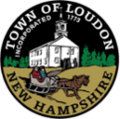Loudon, New Hampshire | |
|---|---|
 Loudon Congregational Church north of the village center | |
 Location in Merrimack County and the state of New Hampshire. | |
| Coordinates: 43°17′08″N71°28′04″W / 43.28556°N 71.46778°W | |
| Country | United States |
| State | New Hampshire |
| County | Merrimack |
| Incorporated | 1773 |
| Villages |
|
| Government | |
| • Board of Selectmen |
|
| • Town Administrator | Brenda Pearl |
| Area | |
• Total | 46.72 sq mi (121.00 km2) |
| • Land | 46.16 sq mi (119.55 km2) |
| • Water | 0.56 sq mi (1.45 km2) 1.20% |
| Elevation | 371 ft (113 m) |
| Population (2020) [2] | |
• Total | 5,576 |
| • Density | 121/sq mi (46.6/km2) |
| Time zone | UTC-5 (Eastern) |
| • Summer (DST) | UTC-4 (Eastern) |
| ZIP code | 03307 |
| Area code | 603 |
| FIPS code | 33-43380 |
| GNIS feature ID | 0873652 |
| Website | www |
Loudon is a town in Merrimack County, New Hampshire, United States. The population was 5,576 at the 2020 census. [2] Loudon is the home of New Hampshire Motor Speedway.
Contents
- History
- Geography
- Adjacent municipalities
- Demographics
- Education
- Media
- Sites of interest
- References
- External links
The main village in town, where 711 people lived at the 2020 census, is defined as the Loudon census-designated place and is located along the Soucook River at the southern terminus of New Hampshire Route 129.


